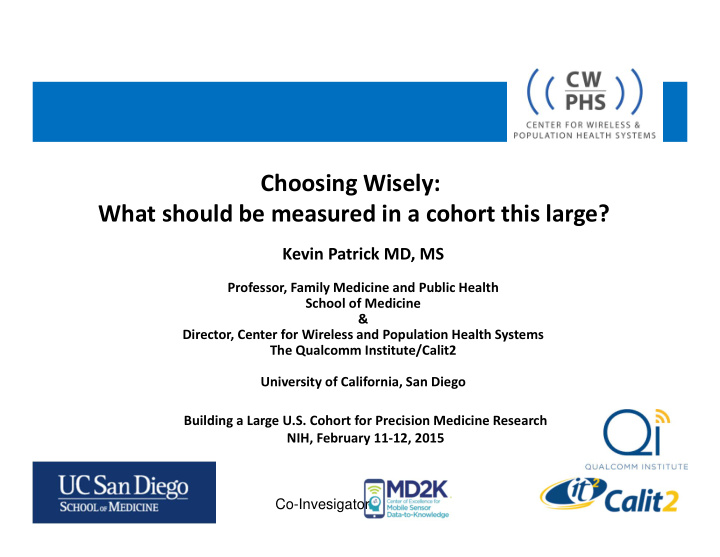



Choosing Wisely: What should be measured in a cohort this large? Kevin Patrick MD, MS Professor, Family Medicine and Public Health School of Medicine & Director, Center for Wireless and Population Health Systems The Qualcomm Institute/Calit2 University of California, San Diego Building a Large U.S. Cohort for Precision Medicine Research NIH, February 11 ‐ 12, 2015 Co-Invesigator
What should be measured? 2005;14(8):1847-50
The Exposome “At it’s most complete, the exposome encompasses life- course environmental exposures (including lifestyle factors), from the prenatal period onwards…” -- Christopher Paul Wild
NI H Exposure Biology Program “Genes load the gun; environm ent pulls the trigger” – Francis Collins, MD, PhD 2007 2008 2009 2010 2011 Environmental Sensors • Diet/Physical Activity DEVICES • Chemicals/Biologics • Psychosocial Stress/Addictive Substances APPLICATION Genome Wide Biological Response Association & • Biomarkers Other FINGERPRINTS • Centers–biomarkers/biosensors DEVICES Research • Inflammation • Oxidative stress • Programmed cell death • Epigenetic markers 4
How can mobile devices and related technologies enhance Precision Medicine research? Greater precision on measures of physiological parameters that can aid in monitoring treatments, treatment response and outcomes. Wireless and/or wearable sensors for: • Heart rate and heart rate variability • Respiration • Blood pressure • Glucose, lactate & electrolytes • Hydration & metabolism • Medication adherence via smart pills, pill bottles and other drug delivery (e.g. inhalers) Spirometry •
How can mobile devices and related technologies enhance Precision Medicine research? Greater precision on measures of behaviors and related health states and their context Wireless and/or wearable sensors for: • Physical activity, sedentary behavior, and overall movement patterns that have unique signatures for underlying disease or health risk (e.g. Parkinson’s, fall risk, etc.) • Diet through self ‐ report with always ‐ available apps or with cameras • Weight (and with BP, hydration status) • Stress • Sleep • Cognitive function • Location via GPS and other mobile phone ‐ based approaches
K. Patrick | Slide 7 Importance of Place to Precision Medicine • Health disparities • Disease clusters • Stress & incivilities • Toxic exposure
GPS Data & Geographic Information Systems (GIS) data • Parks – Distance & density & acreage • Schools – Distance & density Recreation Facilities • – Distance & density • Census data – Housing unit density • Parcel & Land Use Commercial, industrial, institutional, residential, office, open – space, vacant – Retail parcel count Feb 16, 2011 • CoStar / SD County Tax Assessor – Retail floor area ratio • Coastline – Distance to coast • Local & Major Roads – Intersection & cul ‐ de ‐ sac counts 8 GPS from Mobile Phone
How can mobile devices and related technologies enhance Precision Medicine research? Greater precision on measures of experience and subjective states through Ecological Momentary Assessment (EMA), the use of a mobile device to query participants as events happen EMA: • Is highly configurable to the underlying research question(s) • Can be preset or automatically prompted based upon context (e.g. GPS) • Can be intensive on an App, or “light” via quick ‐ response text messages • Can be offered in any language and at multiple levels of literacy and numeracy
How can mobile devices and related technologies enhance Precision Medicine research? Greater precision on measures of social interactions via online social networks, searches and other technologies such as sound, cameras, location and context
How can mobile devices and related technologies enhance Precision Medicine research? Greater precision on measures of environmental exposures such as particulate matter, noise, electromagnetic fields, environmental toxins & other insults that might impact such things as oxidative stress, immune response, hormonal regulation or other phenomena. • Wearable sensors that can store or transmit to/through the mobile phone data on exposures • Combining data from wearable sensors with that from fixed sources in the Environment to enrich the understanding of cumulative exposure • Periodic EMA & other triggered measurement tailored to specific research questions, or such things as occupation, location, natural disaster, or other Circumstance that might influence the natural course of treatment and/or outcomes Peters A et al. J Epidemiol Community Health 2012;66:103-105
CitiSe nse Alwa ys-o n Pa rtic ipa to ry Se nsing fo r Air Qua lity PI : Bill Griswo ld/ UCSD, CSE Co -PI s: K . Pa tric k, I . K rue g e r, T . Ro sing , S. Da sg upta , H. Sha c ha m Cyb e r-Physic a l Syste ms Pro g ra m, NSF , 0932403 12
CitiSense: System Overview Air Pollution Sensor CitiSense Smartphone App CO, NO 2 , O 3 , Humidity, Pressure, Temp Back-end Server Upload Measurements 13
How can mobile devices and related technologies enhance Precision Medicine research? Finally, these devices can support recruitment and retention in Precision Medicine research . • Partner with telcomms on enrollment and tracking over time as participants move (opt in, of course) • Text message reminders for data collection, in ‐ person visits, special queries • Use of text messages, social media, and other communication channels to support queries from and among study participants if questions/issues arise
Recommendations Ideally, all cohort participants will carry a Smartphone and wear a Smartwatch • Movement (accel/gyro) • Movement (accel/gyro) • GPS • Light EMA via SMS • Ecological Momentary Assessment (EMA) • Heart rate/HR variability • Voice/Sound • Specialized apps • Image • Bluetooth connectivity to other devices • Specialized apps Carried as usual Worn 24x7
Recommendations Other mobile and wireless devices ‐ and sources of data ‐ will be used in subsets of the cohort based upon research questions and underlying health state
Recommend
More recommend